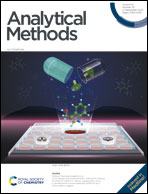Removal of lead from aqueous solution using electrospun nanofibers: preparation, characterization, adsorption isotherm, and kinetic study†
Abstract
Lead is one of the most hazardous toxic heavy metal ions in industrial wastewater. The removal of Pb(II) from aqueous environment is an extremely essential topic due to acquiring clean water resources and its significant impact on human health. Adsorption is an effective and the most widely used method for heavy metal removal from an aqueous medium. Nanofibers have potential advantages in the adsorption of heavy metal ions from wastewater. In this study, nanofibers based on polyvinyl alcohol (PVA) were fabricated for the removal of lead ions from aqueous samples. Nanofibers produced by electrospinning were characterized by scanning electron microscopy (SEM/EDX) and Fourier transform infrared (FT-IR) techniques. A batch system was used for the adsorption of Pb(II) ions onto cross-linked PVA (%10) and PVA (%10):MSs (%2) (Malva Sylestris L. seed biomaterial) nanofibers. The effectiveness of cross-linking was determined by the water absorbency test. The pH, adsorbent amount, adsorption kinetics, isotherms, and thermodynamic values were thoroughly investigated in the adsorption tests. Pb(II) adsorption on the polymer was confirmed by EDX analysis. The optimum values found were a pH of 6, an adsorbent dose of 5.0 mg, and a contact time of 120 min. Lead ion concentrations were determined by flame atomic absorption spectrometry (FAAS). The Freundlich models could explain the results from the adsorption data. Similar results were obtained from adsorption isotherm models, and the results were found to support each other. The adsorption capacity for PVA (10%) and PVA (10%):MSs (2%) nanofibers were found to be 444.2 mg g−1 and 588.2 mg g−1, respectively. The adsorption capacity increases with the addition of MSs (2%) biomaterial. As a result, nanofibers can be used as effective adsorbents in the removal of Pb(II) ions. The developed methods are environmentally friendly and promising for the separation of toxic Pb(II) ions from aqueous systems, which is a major problem for environmental pollution.



 Please wait while we load your content...
Please wait while we load your content...